Calendar
- October 12, 2003 4:30 - 8:00 PM Fall Banquet - JR’s Stockyards Inn, McLean, VA
Registration deadline: October 5, 2003 Cost: $30.00 per plate (Specify Beef or Fish)
- January 11, 2004 1:00 - 4:00 PM Regular meeting at the National Arboretum
- March 28, 2004 1:00 - 4:00 PM Regular meeting at the National Arboretum
Gardens of New Zealand:
From Peaks to Paddocks
by Jeanine Smith
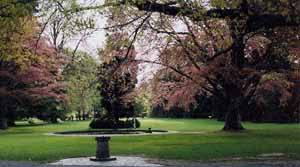 We certainly hope you remembered to send in your registration form for the fall banquet. If you forgot, maybe this newsletter will reach you before the registration deadline. If you have any questions, give Don Hyatt a call.
In addition to the good food and superb speaker, we have some great auction plants too! We certainly hope you remembered to send in your registration form for the fall banquet. If you forgot, maybe this newsletter will reach you before the registration deadline. If you have any questions, give Don Hyatt a call.
In addition to the good food and superb speaker, we have some great auction plants too!
Our speaker is Jeanine Smith who will be flying in from the west coast to share rare vistas of the gardens of New Zealand. Her talk features highlights of several trips to the country. The gardens range from public gardens such as Pukeiti on the slopes of Mt. Taranaki on the North Island, to large estate gardens showcasing varied artistic styles, to small gems of private city gardens, to the farm gardens lovingly created and tended by the owners. The temperate climate with its own spectacular natural features and native plants give the gardens a unique feel.
Jeanine has been a member of the ARS since 1971, and has served in a number of offices locally and nationally including President of the Seattle Rhododendron Society, District 2 Director of the ARS, and ARS Western Vice-President. She is currently chair of the ARS Honors Committee and Vice-President of the Meerkerk Rhododendron Gardens' Board of Directors. She and her husband, Rex, have been gardening on three acres in Woodinville, WA, since 1976. Their garden has been featured in several publications and contains hundreds of rhododendrons, both hybrids and species.
Reminder - Dues are Due
If you haven't paid your dues yet, please send your renewal to our Treasurer, Phyllis Rittman. Dues are $35 per year single, or $40 per couple.
Convention 2006 - Here We Go Again!
If you didn't have a chance to help out with the District 9 Meeting in Annapolis last spring, fear not. There is yet another opportunity to help out with a similar event. Since no ARS chapter was sponsoring the 2006 Convention, the three District 9 ARS chapters (Mason-Dixon, Middle Atlantic, and Potomac Valley) agreed to join forces with the Brookside Gardens Chapter of the Azalea Society of America to host a joint ARS/ASA Convention from May 11-14, 2006.
We have already selected the DoubleTree Inn and Conference Center in Rockville, MD for the site and are sending off rhododendron cuttings to Van Veen Nursery in Portland Oregon who will help root plants for the sale. We will need lots of volunteers so please help out. It will be fun!
Assessing the Damage from Isabel
It may have only been a tropical storm by the time it got to D.C., but the remnants of hurricane Isabel still brought significant damage to our area. The National Arboretum lost many old trees, especially on Mount Hamilton in the Azalea Collection. The chapter did hold its regular meeting that Sunday (9/21/03), although getting into the facility was not easy. Arboretum officials did not want to open to the public due to blocked roads and storm debris. Instead, they shut gates at both entrances and required our members to identify themselves at the R Street entrance to get in. We could not post signs.
Margaret White lost one of her larger oak trees which fell on the smaller guest house beside the barn. That structure was crushed and there were live wires in the yard for nearly a week, but all of her choice plants including R. makinoi ‘Margaret White’ came through just fine.
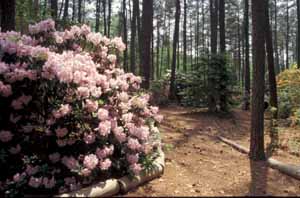 Some of our Associate members in southern Virginia saw much more damage than we did from Isabel. George McLellan in Glouchester, and Ken and Sandra McDonald in Newport News had downed trees but also had to contend with the salt water storm surge in their plantings. Some of our Associate members in southern Virginia saw much more damage than we did from Isabel. George McLellan in Glouchester, and Ken and Sandra McDonald in Newport News had downed trees but also had to contend with the salt water storm surge in their plantings.
The worst damage report so far was in the lovely garden of David and Debby Sauer near Richmond (pictured left). They lost on the order of 100 pine trees in their extensive landscape. Tree root systems are tilted on end everywhere with trunks piled 3 to 4 deep in places. Always the optimist, David notes that their rhododendrons and azaleas will bloom better now with the extra sunlight.
Seed Exchange 2003 -2004
If you made any crosses this year or have any seed from species that you can contribute to our seed exchange, please let Don Hyatt know by mid November. Judging from past exchanges, people seem to be very interested in species seed collected in the wild, especially the native azaleas. This year, we expect to get our seed exchange list out to chapter members by late December with seed distribution scheduled near the January 2004 meeting date.
Van Veen Order
Our chapter submitted a wholesale group order of nearly 500 plants to Van Veen Nursery this year. We expect the plants to be shipped to us so that we can distribute them at our March meeting. We may not be able to get all of the varieties requested, but we will notify those who ordered as we near the delivery date. To meet the five plant minimum per variety, we did order a few extras and will sell them at the meeting.
Flower Show 2004
Next year, we will hold our flower show at the Azalea Society National Convention rather than the National Arboretum. We decided to stage our show at the ASA convention hotel in Bowie, MD, which will be about 15 minutes away from the Arboretum because so many of our regular workers are members of the Ben Morrison Chapter ASA, the convention hosts. We preferred to join forces rather than compete. Convention dates are May 7, 8 and 9, Mother’s Day weekend. More details will be forthcoming.
This Issue Has COLOR!
We hope you appreciate the color pictures in this issue of our newsletter. Since our chapter now receives $8 of your dues rather than the $6 we retained prior to the increase, we thought we would try to upgrade our newsletter with a color insert in at least two issues per year. The color page in this issue shows fifteen different images of some lesser known Gable rhododendrons, and accompanies the article by Jane Goodrich.
"The Past is Prologue" Some Lesser Known Gable Rhododendrons by Jane M. Goodrich
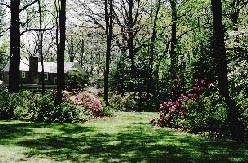 The Potomac Valley Chapter is undertaking a major project: we will establish a Gable grove at the John C. and Margaret K. White Horticultural Center (pictured left). Margaret has transferred her lovely 13-acre garden to Fairfax County as a horticultural park. She already has an outstanding collection of the better known Gables, such as 'Cadis' and 'Caroline', many over 20 feet tall. The Potomac Valley Chapter is undertaking a major project: we will establish a Gable grove at the John C. and Margaret K. White Horticultural Center (pictured left). Margaret has transferred her lovely 13-acre garden to Fairfax County as a horticultural park. She already has an outstanding collection of the better known Gables, such as 'Cadis' and 'Caroline', many over 20 feet tall.
Beginning in the 1930's, Joseph Gable, a nurseryman from Stewartstown, PA, hybridized rhododendrons suitable for the East Coast and continued until he died in 1972. The results were outstanding. In 1973, the Potomac Valley Chapter formed the Gable Study Group[1] to evaluate his work. Combining Gable's original notes with responses to a survey, the results were published in Hybrids and Hybridizers [2]. Many of the plants from Gable's later crosses have since been tested and named. These lesser known clones we will plant in Margaret's garden to complete the collection. As a surviving member of the Gable Study Group, these are my suggestions for the additions -- considered, yes; biased, you bet. (Note: See the color insert where many of these plants are pictured. )
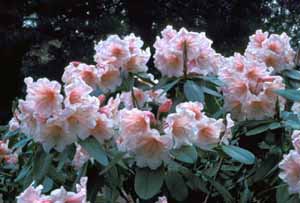
Mt. Siga
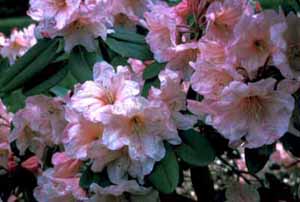
Kulu
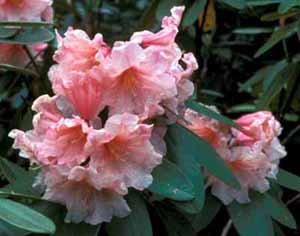
Dr. Rock
| The winner, hands down, is 'Mt. Siga' (R. vernicosum, affinis, Rock #18139). The flowers are peachy-pink. The "affinis" which Gable always attached to the label means "like" the species vernicosum. Is it a vernicosum? Probably not. The seed came from the 1929 Joseph Rock expedition to China. The name 'Mt. Siga' refers to a mountain in southwest Szechwan province of China in the region where the seed was probably collected. Don't look for it on the maps: it's spelled there with a "Z". Its sibling, 'Kulu', is the pinker of the two, and it is named after a city in China in the same general region. Neither plant has been hurt in the last 30 years in northern Virginia, despite some bone dry summers and below-normal winter temperatures.
One of the R.18139's, probably 'Mt. Siga', was crossed with
R. houlstonii to produce "1964", the most outstanding plant to bloom that year. Caroline Gable later named that plant 'Dr. Rock', after the plant explorer whose seed collections came Gable's way. 'Dr. Rock' favors 'Mt. Siga' in color. A sibling from that cross, 'Shell', favors R. houlstonii.
The Gable white R. vernicosum came from seed of Joseph Rock's 1932 expedition to northwest Yunnan. Gable called this his "true vernicosum" to distinguish it from the R.18139's. When Gable was ill with pneumonia, Guy Nearing planted the seed for him, a testament of their long and fruitful friendship.
|
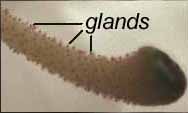 There was an old plant down in Gable's Woods that was long thought to be a hardy white R. decorum. One day it was discovered to have red stylar glands. These glands are small, sticky structures along the style as shown to the right in a close up of a pistil from R. vernicosum.
This meant it could not be decorum but placed it in the vernicosum group instead. Its seed came from the 1924 Rock expedition and its number is R.6829. Its progeny do come true from seed. There was an old plant down in Gable's Woods that was long thought to be a hardy white R. decorum. One day it was discovered to have red stylar glands. These glands are small, sticky structures along the style as shown to the right in a close up of a pistil from R. vernicosum.
This meant it could not be decorum but placed it in the vernicosum group instead. Its seed came from the 1924 Rock expedition and its number is R.6829. Its progeny do come true from seed.
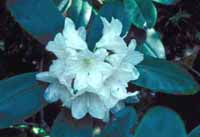
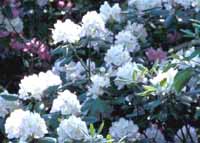 'Anne Glass' (left), a lovely white with a pale green throat, was named for the wife of Powell Glass. The cross is 'Catalgla' x decorum. 'Catalgla' is an acronym for R. catawbiense album var. 'Glass'. Powell Glass found a white R. catawbiense (left) while fishing in a mountain stream in Virginia and sent seed from this plant to Gable.
'Anne Glass' (left), a lovely white with a pale green throat, was named for the wife of Powell Glass. The cross is 'Catalgla' x decorum. 'Catalgla' is an acronym for R. catawbiense album var. 'Glass'. Powell Glass found a white R. catawbiense (left) while fishing in a mountain stream in Virginia and sent seed from this plant to Gable.
|
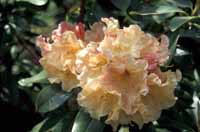
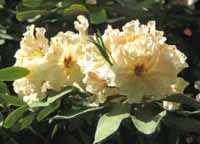 'Mary Belle' (left) is of course an outstanding plant. Its progeny with R.18139 produced a new winner, 'James Allison' (right). Its pale ivory flowers have a deep carmine throat. The medium green foliage lacks the characteristic 'Mary Belle' twist, but it reappears in the next generation. 'Vandal' is a sibling of 'James Allison'; Caroline Gable chose that name because someone stole all of its trusses one night.
'Mary Belle' (left) is of course an outstanding plant. Its progeny with R.18139 produced a new winner, 'James Allison' (right). Its pale ivory flowers have a deep carmine throat. The medium green foliage lacks the characteristic 'Mary Belle' twist, but it reappears in the next generation. 'Vandal' is a sibling of 'James Allison'; Caroline Gable chose that name because someone stole all of its trusses one night.
|
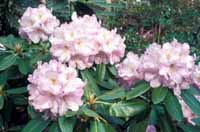 'Mary K' (left), an off-white, was named for Gable's daughter-in-law. It is a cross of the hardy white 'Catalgla' and Gable's hardy R. fortunei. Gable and Nearing worked for seven generations to get the hardiness in fortunei which had come from England. 'Mary K' is hardy in New England. Watch for a pinkish sport.
'Mary K' (left), an off-white, was named for Gable's daughter-in-law. It is a cross of the hardy white 'Catalgla' and Gable's hardy R. fortunei. Gable and Nearing worked for seven generations to get the hardiness in fortunei which had come from England. 'Mary K' is hardy in New England. Watch for a pinkish sport.
|
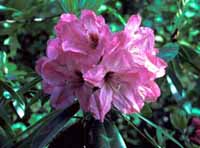 'Mac Kantruss' (left) is named for a Gable grandson. It is a pale red with distinct red throat and blooms a bit later than mid season. One year it won Best in Show at the Potomac Valley Truss Show. The cross is 'Degram' x 'Atrier'. 'Hopewell' is a sibling.
'Mac Kantruss' (left) is named for a Gable grandson. It is a pale red with distinct red throat and blooms a bit later than mid season. One year it won Best in Show at the Potomac Valley Truss Show. The cross is 'Degram' x 'Atrier'. 'Hopewell' is a sibling.
|
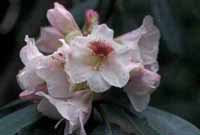 'Rhein's Find' (left) was selected from the plants of the cross 'Kluis Sensation' x 'Cadis'. It's charm comes from a pale red blotch set in an off-white flower.
'Rhein's Find' (left) was selected from the plants of the cross 'Kluis Sensation' x 'Cadis'. It's charm comes from a pale red blotch set in an off-white flower.
|
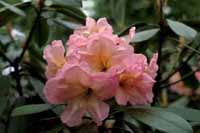 'Peaches'(left) came from a selection in Gable's Woods where the results of the cross 'Atroflo' x 'Atrier' were planted. This is probably the correct parentage. The trusses open a clear peach color with no blue cast and it becomes a tall plant in time.
'Peaches'(left) came from a selection in Gable's Woods where the results of the cross 'Atroflo' x 'Atrier' were planted. This is probably the correct parentage. The trusses open a clear peach color with no blue cast and it becomes a tall plant in time.
|
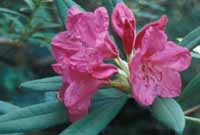 'Atroflo #2' (left) is a great red with outstanding indumented foliage. It will bloom in shade or partial shade and buds up young. There are actually three numbered "Atroflo's": #1 got the Award of Excellence, #2 is the hardier, and #3 is sparsely available. Gable recorded the cross as 'Atrosanguineum' x floccigerum Rock 18469. The latter was a plant from Joseph Rock's 1929 expedition to China. Fearing his floccigerum was tender, Gable dug the plant each fall and wintered it in his barn. The parentage of 'Atroflo' has come under much discussion and many opinions have been aired. 'Atroflo #2' has been selfed but we will have to wait for the results to ascertain the parentage.
'Atroflo #2' (left) is a great red with outstanding indumented foliage. It will bloom in shade or partial shade and buds up young. There are actually three numbered "Atroflo's": #1 got the Award of Excellence, #2 is the hardier, and #3 is sparsely available. Gable recorded the cross as 'Atrosanguineum' x floccigerum Rock 18469. The latter was a plant from Joseph Rock's 1929 expedition to China. Fearing his floccigerum was tender, Gable dug the plant each fall and wintered it in his barn. The parentage of 'Atroflo' has come under much discussion and many opinions have been aired. 'Atroflo #2' has been selfed but we will have to wait for the results to ascertain the parentage.
|
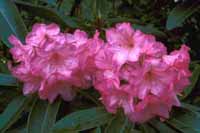 'Mary Yates' (left) was named by Henry Yates. He and Joe Gable made the cross 'Marcath' F2. The shared seed produced for Gable the series called 'Tommies', which included 'Bonnie' and 'Little Bonnie', and many clones only identified by numbers. They are bicolors and solids. Caroline Gable said this group was exceptionally brilliant pink even on cloudy days.
'Mary Yates' (left) was named by Henry Yates. He and Joe Gable made the cross 'Marcath' F2. The shared seed produced for Gable the series called 'Tommies', which included 'Bonnie' and 'Little Bonnie', and many clones only identified by numbers. They are bicolors and solids. Caroline Gable said this group was exceptionally brilliant pink even on cloudy days.
|
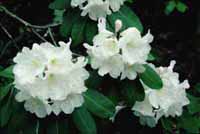 Plants of fortunei x 'Madonna' and the reverse cross, 'Madonna' x fortunei (‘Madfort’ pictured left), were planted side-by-side in Gable's Woods. Both crosses produced lovely whites. Enthusiasts who bought seedlings often made cuttings and sent them back to Gable, explaining that he had sold them the best one and he should have a plant to keep. The clone that goes to Margaret's garden is fortunei x 'Madonna'. It buds up young.
Plants of fortunei x 'Madonna' and the reverse cross, 'Madonna' x fortunei (‘Madfort’ pictured left), were planted side-by-side in Gable's Woods. Both crosses produced lovely whites. Enthusiasts who bought seedlings often made cuttings and sent them back to Gable, explaining that he had sold them the best one and he should have a plant to keep. The clone that goes to Margaret's garden is fortunei x 'Madonna'. It buds up young.
|
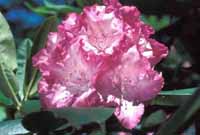 'Catmar'(left) ('Catalgla' x 'Mars') has several forms. They are all robust growers with large leaves and are hardy in southern Canada. The deep edging of each flower surrounds a center of marshmallow-like white. The plus: deer don't seem to like it. The minus: it's a bit hard to root.
'Catmar'(left) ('Catalgla' x 'Mars') has several forms. They are all robust growers with large leaves and are hardy in southern Canada. The deep edging of each flower surrounds a center of marshmallow-like white. The plus: deer don't seem to like it. The minus: it's a bit hard to root.
|
'Nearing Pink' is a plant hybridized by Guy Nearing who shared seed with Gable. Gable wrote of the seedlings of this cross (which bloomed in 1954), "the finest of this group of hybrids from Nearing". Surprisingly, the cross is (decorum x griffithianum) x (williamsianum x auklandii). R. auklandii is another name for R. griffithianum. Seed from both of these parents came from Mr. Magor in England. Whether the seed of both were hand pollinated or gathered open pollinated is a matter of conjecture. We do know that Nearing kept plants of 'DeGriff' (there were only six of them) in his hand dug pit. Whatever the explanation for the hardiness, 'Nearing Pink' is a beautiful medium pink with a cherry red throat, blooming about three weeks later than 'David Gable'.
|
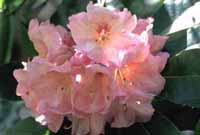 One spring a few of the Gable Study Group were in Gable's Woods with Caroline Gable. We stopped near a lovely apricot pink. The charts we had indicated the cross was 'Maxhaem' x 'Caroline'. Caroline remembered that the plant 55-64 introduced as 'W. H. Ebaugh' (left) came from that spot, so at last there was a match for the parentage. Another clone, 56-64, is a sibling.
One spring a few of the Gable Study Group were in Gable's Woods with Caroline Gable. We stopped near a lovely apricot pink. The charts we had indicated the cross was 'Maxhaem' x 'Caroline'. Caroline remembered that the plant 55-64 introduced as 'W. H. Ebaugh' (left) came from that spot, so at last there was a match for the parentage. Another clone, 56-64, is a sibling.
|
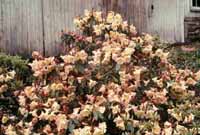 'Mary Garrison' (left) is a cross of vernicosum, aff. R.18139 with a cream colored fortunei. The latter was found in a batch of fortunei seedlings. The resulting plant has a large lax truss of pinkish cream with a distinct reddish-brown blotch and that blotch seems to be dominant in future generations with 'Mary Garrison'. You have to love a lax truss or set the plant on a bank to look up into the flowers. 'Mary Garrison' has produced some very nice progeny.
'Mary Garrison' (left) is a cross of vernicosum, aff. R.18139 with a cream colored fortunei. The latter was found in a batch of fortunei seedlings. The resulting plant has a large lax truss of pinkish cream with a distinct reddish-brown blotch and that blotch seems to be dominant in future generations with 'Mary Garrison'. You have to love a lax truss or set the plant on a bank to look up into the flowers. 'Mary Garrison' has produced some very nice progeny.
|
Many thanks to all those who have supplied cuttings, rooted the cuttings, and nurtured them along. As these young plants get larger, they will be moved to a permanent display area in Margaret's garden for future generations to enjoy. Special gratitude, of course, goes to Joseph Gable who hybridized all these beauties.
[1] Gable Study Group members: George Ring III (chairman), Caroline Gable, Ray and Jane Goodrich, Russ and Velma Haag, and George Miller.
[2] Hybrids and Hybridizers: Rhododendrons and Azaleas for Eastern North America, Philip A. Livingston and Franklin H. West, editors, Harrowood Books, Newtown Square, PA, 1978.
Thoughts on Botanical Correctness
Experts in the Rhododendron Email Group have been very helpful in letting us know the right way to use technical terms associated with rhododendrons. If you don't already belong to that email group and want to participate, check out yahoogroups.com on the Internet and join the group rhodo. People usually don't condemn others for using terms incorrectly but the goal is for people to try to be botanically correct.
One ongoing discussion this past year has been using the term "floret" in relation to rhododendron trusses. I know have used that term for years to describe an individual flower but apparently that is wrong. According to the majority of the online experts, the proper use of the botanical term "floret" should be reserved for an extremely tiny flower in something like a grass. It should not be used with rhododendrons. The individual blossoms in a truss should simply be called "flowers" and the term floret should not really be used in association with rhododendrons.
Another concern is how to cite names of rhododendrons in print. Species names should be written in italics with either full name of the genus or an abbreviation preceding the species name, such as Rhododendron makinoi or R. makinoi. When the genus is used in a formal name, the "R" of Rhododendron should be capitalized with the rest of the name in lower case. A hybrid, on the other hand, should be capitalized and in single quotes but not italics, such as 'Pink Pearl'.
I can handle those things but I am having trouble with results of the recent reclassification in the genus Rhododendron. You see, taxonomists have changed many familiar names. For instance, some prominent species like R. metternichii, R. yakushimanum, and R. degronianum are thought to be too closely related for separate distinction and are considered just subspecies or variants of R. degronianum. Thus, yakushimanum is now officially R. degronianum ssp. yakushimanum, metternichii is R. degronianum ssp. heptamerum, and degronianum is simply R. degronianum ssp. degronianum. I must admit that am still using the old names since I can tolerate inaccuracy better than I can deal with writing long plant labels.
The Azalea Species
Deciduous Azalea Species
When taxonomists studied the azalea species[1][2], they made a number of changes. Azaleas are now grouped into two subgenera. One subgenus is Tsutsusi with two sections: Tsutsusi for the evergreen azaleas and Brachycalyx for oriental deciduous azaleas with leaves in groups of two to three. The other subgenus is Pentanthera and it has several sections: Pentanthera, Rhodora, Sciadorhodion, and Nipponicum. Our North American natives are in subgenus Pentanthera and either section Pentanthera or Rhodora.

R. eastmanii
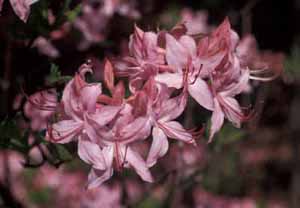
R. prinophyllum (roseum)
|
In section Pentanthera, the species known as R. molle from China and R. japonicum from Japan are now considered just regional variants of the same species, R. molle. R. japonicum is officially now R. molle subspecies japonicum.
Also, the species R. viscosum now includes several other former species: R. coryi, R. oblongifolium, and R. serrulatum. A new deciduous azalea species from South Carolina, R. eastmanii, was just identified in 1999. [4] (pictured left)
Some familiar native azalea names were changed to follow the rules of nomenclature. Our most common pale pink native azalea found in the region was previously known as R. nudiflorum but it is now officially called R. periclymenoides. The fragrant, deep rose pink native found in upper elevations of our eastern mountain ranges that we knew as R. roseum is now called R. prinophyllum. (pictured left)
The orange-red native azalea from the Cumberland Plateau that is often confused with the Flame Azalea (R. calendulaceum) was called R. bakeri but is now R. cumberlandense. R. speciosum is now called R. flammeum.
|
Subgenus Tsutsusi section Brachycalyx contains 15 deciduous azalea species, some of which were previously under a subseries called Schlippenbachii.
Below is a list of some deciduous azalea species organized by geographical region.* After the name is a two letter pair to indicate classification. The first letter denotes subgenus (Pentanthera or Tsutsusi) and the second is the section (Brachycalyx, Pentanthera, Rhodora, Sciadorhodion, or Nipponicum). For instance, all plants with the designation (PP) belong to subgenus Pentanthera section Pentanthera and are relatively closely related and often cross.
NORTH AMERICA
-
R. alabamense (PP)
R. arborescens (PP)
R. atlanticum (PP)
R. austrinum (PP)
R. calendulaceum (PP)
R. canadense (PR)
R. canescens (PP)
R. cumberlandense (R. bakeri) (PP)
R. eastmanii (PP)
R. flammeum ( R. speciosum ) (PP)
R. occidentale (PP)
R. periclymenoides ( R. nudiflorum) (PP)
R. prinophyllum ( R. roseum ) (PP)
R. prunifolium (PP)
R. vaseyi (PR)
R. viscosum ( includes former species R. coryi,
R. oblongifolium, and R. serrulatum ) (PP)
EUROPE
-
R. luteum (PP)
CHINA
-
R. farrerae (TB)
R. mariesii (TB)
R. molle ssp. molle ( former R. molle ) (PP)
JAPAN
-
R. albrechtii (PS)
R. amagianum (TB)
R. dilatatum (TB)
R. molle ssp. japonicum (R. japonicum) (PP)
R. nipponicum (PV)
R. nudipes (TB)
R. pentaphyllum (PS)
R. quinquefolium (PS)
R. reticulatum (TB)
R. sanctum (TB)
R. weyrichii (TB)
KOREA
-
R. schlippenbachii (PS)
* Geographic distribution of the deciduous azalea species: China (4), Japan (17), Korea (1), Europe(1), and North America(16).
Evergreen Azalea Species
The are 66 evergreen azalea species that belong to the subgenus Tsutsusi section Tsutsusi. It is equivalent to the former Azalea subseries Obtusum. There are many more species listed now because of plants identified by P. X. Tan in a 1983 survey of rhododendrons in China [4], and also the new R. arunachalense, identified in northeast India by Chamberlain and Rae [1]. Its range is the farthest west of any known evergreen azalea.
There is an interesting species R. tashiroi which seems to be intermediate between Tsutsusi and Brachycalyx. It has now been placed in the section Tsutsusi rather than giving it separate distinction as previously listed in the literature.
Surprisingly, the majority of the evergreen azalea species in the section Tsutsusi are not currently in cultivation and we do not know their garden value. The following list shows some of the more familiar evergreen species and are grouped by geographic region.*
CHINA
-
R. microphyton
R. simsii
JAPAN
-
R. eriocarpum ( The former R. tamurae is
now considered a variation of this species )
R. indicum
R. kaempferi
R. kiusianum var. kiusianum, and kiusianum
var. sataense, formerly R. sataense
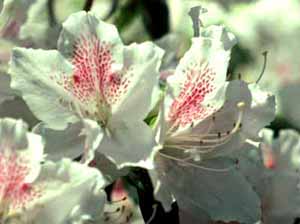 R. mucronatum This has seen changes too and as of 1998, it no longer carries species status. The species had been a synonym for ledifolia alba and indica alba but the Edinburgh Journal of Botany, Volume 47, No. 2 (1990) Chamberlain and Rae listed it as R. mucronatum var. mucronatum. The form called ’Sekidera’ or also 'Magnifica' has a red blotch (shown to the right). They were considered white cultivars of the species once known as R. ripense. R. ripense was at that time listed as R. mucronatum var. ripense. However in The Rhododendron Handbook (1998), the taxonomists decided that R. mucronatum was likely a hybrid of
R. ripense and R. stenopetalum (formerly R. macrosepalum).
R. mucronatum This has seen changes too and as of 1998, it no longer carries species status. The species had been a synonym for ledifolia alba and indica alba but the Edinburgh Journal of Botany, Volume 47, No. 2 (1990) Chamberlain and Rae listed it as R. mucronatum var. mucronatum. The form called ’Sekidera’ or also 'Magnifica' has a red blotch (shown to the right). They were considered white cultivars of the species once known as R. ripense. R. ripense was at that time listed as R. mucronatum var. ripense. However in The Rhododendron Handbook (1998), the taxonomists decided that R. mucronatum was likely a hybrid of
R. ripense and R. stenopetalum (formerly R. macrosepalum).
R. ripense (For several years it was discontinued but as of 1998, it's back again.)
R. scabrum
R. serpyllifolium and R. serpyllifolium var.
albiflorum
R. stenopetalum This new species name
now replaces the previous species R.
macrosepalum because of reclassification.
Also, R. linearifolium is now listed as R.
stenopetalum 'Linearifolium'.
R. tashiroi
R. tosaense ( R. komiyamae is a synonym )
R. tschonoskii
R. tsusiophyllum
Note: The former Japanese species R. obtusum has been dropped and plants that came under that name are now considered members of the Obtusum Group. Most azaleas under that species name were either hybrids or selections of R. kaempferi and R. kiusianum.
KOREA
-
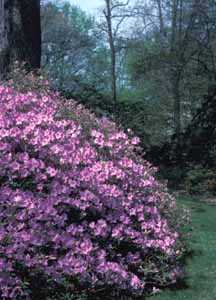 R. yedoense The double flowered form is R.
yedoense var. yedoense (formerly known as just R. yedoense but also listed under the variety name 'Yedogawa'). It is only known in cultivation and has never been found in the wild. The widespread, lavender species formerly known as R. poukhanense is now R. yedoense var. poukhanense ( right). By the rules of plant nomenclature, the name yedoense had been published prior to that of poukhanense and thus takes precedence. R. yedoense The double flowered form is R.
yedoense var. yedoense (formerly known as just R. yedoense but also listed under the variety name 'Yedogawa'). It is only known in cultivation and has never been found in the wild. The widespread, lavender species formerly known as R. poukhanense is now R. yedoense var. poukhanense ( right). By the rules of plant nomenclature, the name yedoense had been published prior to that of poukhanense and thus takes precedence.
TAIWAN
-
R. nakaharae
R. oldhamii
R. rubropilosum
* Geographic distribution of evergreen azalea species in the Section Tsutsusi: China (39), Japan (13), Korea (1), Taiwan (10), Philippines (1), Vietnam (1), and India (1).
This may seem overly complex, but as one reads current publications using the new azalea names and tries to relate that information to prior references, things can be very confusing. Perhaps this summary will help us understand.
Personally, I would have erred on the side of simplicity rather than strict nomenclature rules. If a name had been widely published for 50 to 100 years, perhaps we could let it stay. Interestingly, the genus Ledum was just moved into the genus Rhododendron so there was fear that they might rename Rhododendron. Ledum was published first. Sanity reigns, so far...
Bibliography:
[1] Chamberlain, D.F. & Rae, S.J., "A Revision
of Rhododendron, IV Subgenus Tsutsusi",
Edinburgh Journal of Botany, Volume 47,
No. 2 (1990)
[2] Kron, Kathleen A., "A Revision of
Rhododendron Section Pentanthera",
Edinburgh Journal of Botany, Volume 50,
No. 3 (1993)
[3] Kron, Kathleen A. and Creel, Mike, "A New
Species of Deciduous Azalea", NOVON 9: pp.
377-380. (1999)
[4] Tam, Puicheung (Tan, Peixiong), A Survey of
the Genus Rhododendron in South China,
World-wide Publications, Hong Kong. (1983)
|
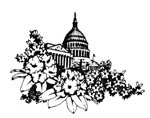
 We certainly hope you remembered to send in your registration form for the fall banquet. If you forgot, maybe this newsletter will reach you before the registration deadline. If you have any questions, give Don Hyatt a call.
In addition to the good food and superb speaker, we have some great auction plants too!
We certainly hope you remembered to send in your registration form for the fall banquet. If you forgot, maybe this newsletter will reach you before the registration deadline. If you have any questions, give Don Hyatt a call.
In addition to the good food and superb speaker, we have some great auction plants too!
 Some of our Associate members in southern Virginia saw much more damage than we did from Isabel. George McLellan in Glouchester, and Ken and Sandra McDonald in Newport News had downed trees but also had to contend with the salt water storm surge in their plantings.
Some of our Associate members in southern Virginia saw much more damage than we did from Isabel. George McLellan in Glouchester, and Ken and Sandra McDonald in Newport News had downed trees but also had to contend with the salt water storm surge in their plantings.
 The Potomac Valley Chapter is undertaking a major project: we will establish a Gable grove at the John C. and Margaret K. White Horticultural Center (pictured left). Margaret has transferred her lovely 13-acre garden to Fairfax County as a horticultural park. She already has an outstanding collection of the better known Gables, such as 'Cadis' and 'Caroline', many over 20 feet tall.
The Potomac Valley Chapter is undertaking a major project: we will establish a Gable grove at the John C. and Margaret K. White Horticultural Center (pictured left). Margaret has transferred her lovely 13-acre garden to Fairfax County as a horticultural park. She already has an outstanding collection of the better known Gables, such as 'Cadis' and 'Caroline', many over 20 feet tall.



 There was an old plant down in Gable's Woods that was long thought to be a hardy white R. decorum. One day it was discovered to have red stylar glands. These glands are small, sticky structures along the style as shown to the right in a close up of a pistil from R. vernicosum.
This meant it could not be decorum but placed it in the vernicosum group instead. Its seed came from the 1924 Rock expedition and its number is R.6829. Its progeny do come true from seed.
There was an old plant down in Gable's Woods that was long thought to be a hardy white R. decorum. One day it was discovered to have red stylar glands. These glands are small, sticky structures along the style as shown to the right in a close up of a pistil from R. vernicosum.
This meant it could not be decorum but placed it in the vernicosum group instead. Its seed came from the 1924 Rock expedition and its number is R.6829. Its progeny do come true from seed.

 'Anne Glass' (left), a lovely white with a pale green throat, was named for the wife of Powell Glass. The cross is 'Catalgla' x decorum. 'Catalgla' is an acronym for R. catawbiense album var. 'Glass'. Powell Glass found a white R. catawbiense (left) while fishing in a mountain stream in Virginia and sent seed from this plant to Gable.
'Anne Glass' (left), a lovely white with a pale green throat, was named for the wife of Powell Glass. The cross is 'Catalgla' x decorum. 'Catalgla' is an acronym for R. catawbiense album var. 'Glass'. Powell Glass found a white R. catawbiense (left) while fishing in a mountain stream in Virginia and sent seed from this plant to Gable.
 'Mary Belle' (left) is of course an outstanding plant. Its progeny with R.18139 produced a new winner, 'James Allison' (right). Its pale ivory flowers have a deep carmine throat. The medium green foliage lacks the characteristic 'Mary Belle' twist, but it reappears in the next generation. 'Vandal' is a sibling of 'James Allison'; Caroline Gable chose that name because someone stole all of its trusses one night.
'Mary Belle' (left) is of course an outstanding plant. Its progeny with R.18139 produced a new winner, 'James Allison' (right). Its pale ivory flowers have a deep carmine throat. The medium green foliage lacks the characteristic 'Mary Belle' twist, but it reappears in the next generation. 'Vandal' is a sibling of 'James Allison'; Caroline Gable chose that name because someone stole all of its trusses one night.
 'Mary K' (left), an off-white, was named for Gable's daughter-in-law. It is a cross of the hardy white 'Catalgla' and Gable's hardy R. fortunei. Gable and Nearing worked for seven generations to get the hardiness in fortunei which had come from England. 'Mary K' is hardy in New England. Watch for a pinkish sport.
'Mary K' (left), an off-white, was named for Gable's daughter-in-law. It is a cross of the hardy white 'Catalgla' and Gable's hardy R. fortunei. Gable and Nearing worked for seven generations to get the hardiness in fortunei which had come from England. 'Mary K' is hardy in New England. Watch for a pinkish sport.
 'Mac Kantruss' (left) is named for a Gable grandson. It is a pale red with distinct red throat and blooms a bit later than mid season. One year it won Best in Show at the Potomac Valley Truss Show. The cross is 'Degram' x 'Atrier'. 'Hopewell' is a sibling.
'Mac Kantruss' (left) is named for a Gable grandson. It is a pale red with distinct red throat and blooms a bit later than mid season. One year it won Best in Show at the Potomac Valley Truss Show. The cross is 'Degram' x 'Atrier'. 'Hopewell' is a sibling.
 'Rhein's Find' (left) was selected from the plants of the cross 'Kluis Sensation' x 'Cadis'. It's charm comes from a pale red blotch set in an off-white flower.
'Rhein's Find' (left) was selected from the plants of the cross 'Kluis Sensation' x 'Cadis'. It's charm comes from a pale red blotch set in an off-white flower.
 'Peaches'(left) came from a selection in Gable's Woods where the results of the cross 'Atroflo' x 'Atrier' were planted. This is probably the correct parentage. The trusses open a clear peach color with no blue cast and it becomes a tall plant in time.
'Peaches'(left) came from a selection in Gable's Woods where the results of the cross 'Atroflo' x 'Atrier' were planted. This is probably the correct parentage. The trusses open a clear peach color with no blue cast and it becomes a tall plant in time.
 'Atroflo #2' (left) is a great red with outstanding indumented foliage. It will bloom in shade or partial shade and buds up young. There are actually three numbered "Atroflo's": #1 got the Award of Excellence, #2 is the hardier, and #3 is sparsely available. Gable recorded the cross as 'Atrosanguineum' x floccigerum Rock 18469. The latter was a plant from Joseph Rock's 1929 expedition to China. Fearing his floccigerum was tender, Gable dug the plant each fall and wintered it in his barn. The parentage of 'Atroflo' has come under much discussion and many opinions have been aired. 'Atroflo #2' has been selfed but we will have to wait for the results to ascertain the parentage.
'Atroflo #2' (left) is a great red with outstanding indumented foliage. It will bloom in shade or partial shade and buds up young. There are actually three numbered "Atroflo's": #1 got the Award of Excellence, #2 is the hardier, and #3 is sparsely available. Gable recorded the cross as 'Atrosanguineum' x floccigerum Rock 18469. The latter was a plant from Joseph Rock's 1929 expedition to China. Fearing his floccigerum was tender, Gable dug the plant each fall and wintered it in his barn. The parentage of 'Atroflo' has come under much discussion and many opinions have been aired. 'Atroflo #2' has been selfed but we will have to wait for the results to ascertain the parentage.
 'Mary Yates' (left) was named by Henry Yates. He and Joe Gable made the cross 'Marcath' F2. The shared seed produced for Gable the series called 'Tommies', which included 'Bonnie' and 'Little Bonnie', and many clones only identified by numbers. They are bicolors and solids. Caroline Gable said this group was exceptionally brilliant pink even on cloudy days.
'Mary Yates' (left) was named by Henry Yates. He and Joe Gable made the cross 'Marcath' F2. The shared seed produced for Gable the series called 'Tommies', which included 'Bonnie' and 'Little Bonnie', and many clones only identified by numbers. They are bicolors and solids. Caroline Gable said this group was exceptionally brilliant pink even on cloudy days.
 Plants of fortunei x 'Madonna' and the reverse cross, 'Madonna' x fortunei (‘Madfort’ pictured left), were planted side-by-side in Gable's Woods. Both crosses produced lovely whites. Enthusiasts who bought seedlings often made cuttings and sent them back to Gable, explaining that he had sold them the best one and he should have a plant to keep. The clone that goes to Margaret's garden is fortunei x 'Madonna'. It buds up young.
Plants of fortunei x 'Madonna' and the reverse cross, 'Madonna' x fortunei (‘Madfort’ pictured left), were planted side-by-side in Gable's Woods. Both crosses produced lovely whites. Enthusiasts who bought seedlings often made cuttings and sent them back to Gable, explaining that he had sold them the best one and he should have a plant to keep. The clone that goes to Margaret's garden is fortunei x 'Madonna'. It buds up young.
 'Catmar'(left) ('Catalgla' x 'Mars') has several forms. They are all robust growers with large leaves and are hardy in southern Canada. The deep edging of each flower surrounds a center of marshmallow-like white. The plus: deer don't seem to like it. The minus: it's a bit hard to root.
'Catmar'(left) ('Catalgla' x 'Mars') has several forms. They are all robust growers with large leaves and are hardy in southern Canada. The deep edging of each flower surrounds a center of marshmallow-like white. The plus: deer don't seem to like it. The minus: it's a bit hard to root.
 One spring a few of the Gable Study Group were in Gable's Woods with Caroline Gable. We stopped near a lovely apricot pink. The charts we had indicated the cross was 'Maxhaem' x 'Caroline'. Caroline remembered that the plant 55-64 introduced as 'W. H. Ebaugh' (left) came from that spot, so at last there was a match for the parentage. Another clone, 56-64, is a sibling.
One spring a few of the Gable Study Group were in Gable's Woods with Caroline Gable. We stopped near a lovely apricot pink. The charts we had indicated the cross was 'Maxhaem' x 'Caroline'. Caroline remembered that the plant 55-64 introduced as 'W. H. Ebaugh' (left) came from that spot, so at last there was a match for the parentage. Another clone, 56-64, is a sibling.
 'Mary Garrison' (left) is a cross of vernicosum, aff. R.18139 with a cream colored fortunei. The latter was found in a batch of fortunei seedlings. The resulting plant has a large lax truss of pinkish cream with a distinct reddish-brown blotch and that blotch seems to be dominant in future generations with 'Mary Garrison'. You have to love a lax truss or set the plant on a bank to look up into the flowers. 'Mary Garrison' has produced some very nice progeny.
'Mary Garrison' (left) is a cross of vernicosum, aff. R.18139 with a cream colored fortunei. The latter was found in a batch of fortunei seedlings. The resulting plant has a large lax truss of pinkish cream with a distinct reddish-brown blotch and that blotch seems to be dominant in future generations with 'Mary Garrison'. You have to love a lax truss or set the plant on a bank to look up into the flowers. 'Mary Garrison' has produced some very nice progeny.


 R. mucronatum This has seen changes too and as of 1998, it no longer carries species status. The species had been a synonym for ledifolia alba and indica alba but the Edinburgh Journal of Botany, Volume 47, No. 2 (1990) Chamberlain and Rae listed it as R. mucronatum var. mucronatum. The form called ’Sekidera’ or also 'Magnifica' has a red blotch (shown to the right). They were considered white cultivars of the species once known as R. ripense. R. ripense was at that time listed as R. mucronatum var. ripense. However in The Rhododendron Handbook (1998), the taxonomists decided that R. mucronatum was likely a hybrid of
R. ripense and R. stenopetalum (formerly R. macrosepalum).
R. mucronatum This has seen changes too and as of 1998, it no longer carries species status. The species had been a synonym for ledifolia alba and indica alba but the Edinburgh Journal of Botany, Volume 47, No. 2 (1990) Chamberlain and Rae listed it as R. mucronatum var. mucronatum. The form called ’Sekidera’ or also 'Magnifica' has a red blotch (shown to the right). They were considered white cultivars of the species once known as R. ripense. R. ripense was at that time listed as R. mucronatum var. ripense. However in The Rhododendron Handbook (1998), the taxonomists decided that R. mucronatum was likely a hybrid of
R. ripense and R. stenopetalum (formerly R. macrosepalum).  R. yedoense The double flowered form is R.
yedoense var. yedoense (formerly known as just R. yedoense but also listed under the variety name 'Yedogawa'). It is only known in cultivation and has never been found in the wild. The widespread, lavender species formerly known as R. poukhanense is now R. yedoense var. poukhanense ( right). By the rules of plant nomenclature, the name yedoense had been published prior to that of poukhanense and thus takes precedence.
R. yedoense The double flowered form is R.
yedoense var. yedoense (formerly known as just R. yedoense but also listed under the variety name 'Yedogawa'). It is only known in cultivation and has never been found in the wild. The widespread, lavender species formerly known as R. poukhanense is now R. yedoense var. poukhanense ( right). By the rules of plant nomenclature, the name yedoense had been published prior to that of poukhanense and thus takes precedence.